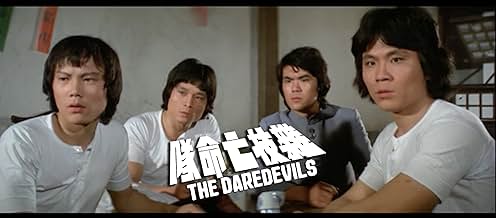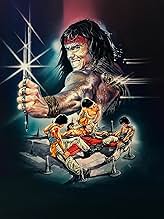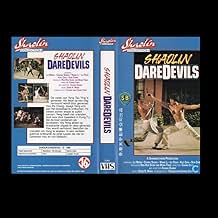DAREDEVILS OF KUNG FU (1979) is one of a series of Shaw Bros. kung fu films featuring the actors known collectively as the Five Venoms. It's also one of the few that has all five of the Venoms operating together as a team. There aren't as many fight scenes as in most Venoms films. Most of the action consists of acrobatics, which the Venoms perform (expertly) to earn eating money. The big brawl in a warehouse at the end has three of the five, Kuo Chui, Lu Feng and Chiang Sheng, taking on the chief bad guys, including General Han, played by Wang Li, a frequent co-star of the Venoms.
Set in the early 20th century, the plot involves corrupt military men and civil war and is all shot on Shaw Bros. studio sets. One of the Venom characters gets killed half-way through the film, so the other four plan an elaborate sting operation to get revenge. They use the dead man's money and bankbook to put one over on General Han by making Lu Feng out to be a top officer's son. They claim they've got weapons to sell to the general, but all they have to show are a machine gun and two pistols, which were actually lifted by the boys from an armory in an abortive robbery attempt. At some point the general's men receive the robbery report and put two & two together.
This is an unusual entry in the Venoms series, but it's not one of the best. The actors are all good and fun to watch together, but the plot, despite some clever scenes, is just not very compelling. Still, it remains a must-see film for Venoms fans.
ADDENDUM (4/28/13): Since writing the above review, I've re-watched the film on Celestial's R3 DVD (released as THE DAREDEVILS) and was much more impressed with it overall. Of all the Five Venoms films, this one gives us more of an opportunity to appreciate these actors as true artists of kung fu performance. Three of them (Kuo Chui, Chiang Sheng and Lu Feng) play street performers who do a highly enjoyable acrobatic act several times in the film. Kuo and Chiang perform a separate act without Lu later in the film at a reception for the General. At the end, the big fight finale in the warehouse between the three of them and the General and his bodyguards is staged and filmed like a performance, with many of the acrobatic routines incorporated into the action choreography. Kung fu on film was often more of a performance art than a martial or fighting art and this film demonstrates that quite vividly.




























